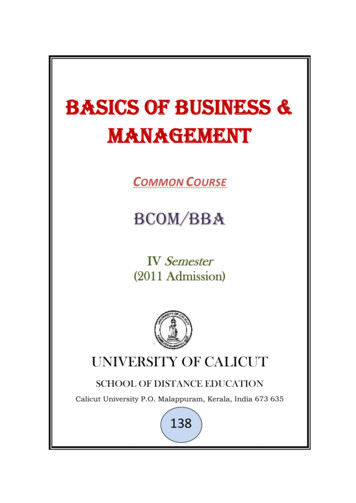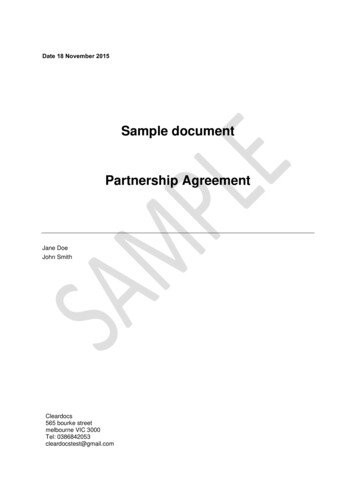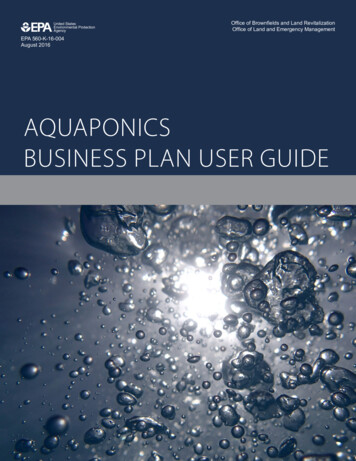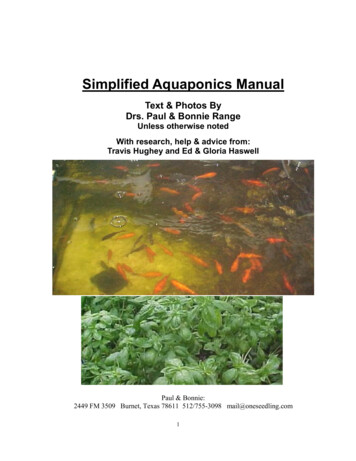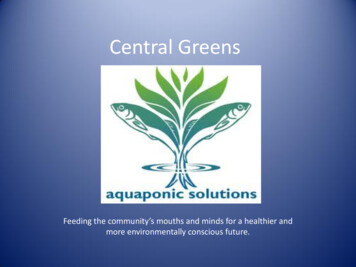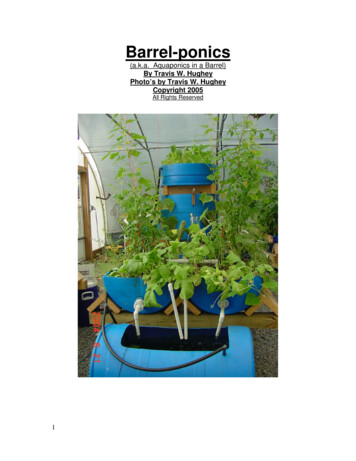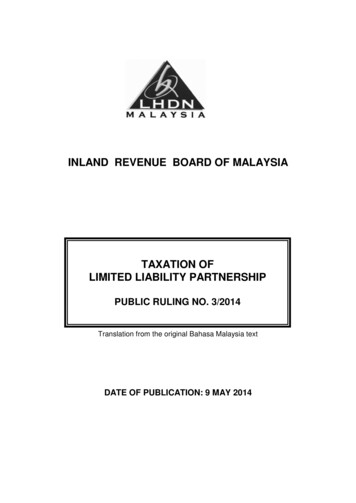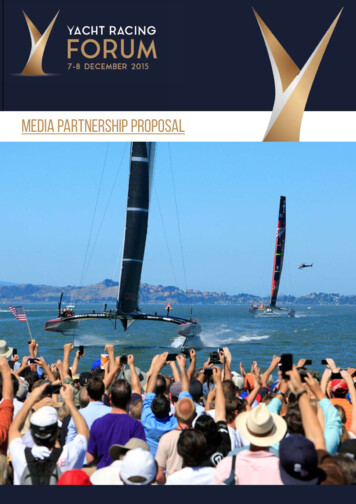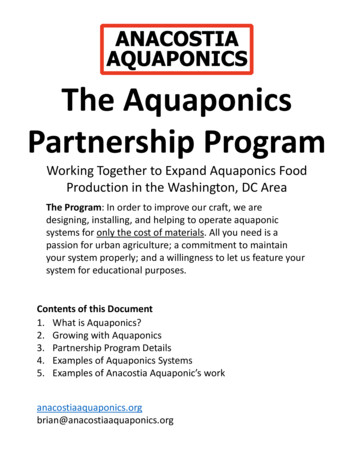
Transcription
The AquaponicsPartnership ProgramWorking Together to Expand Aquaponics FoodProduction in the Washington, DC AreaThe Program: In order to improve our craft, we aredesigning, installing, and helping to operate aquaponicsystems for only the cost of materials. All you need is apassion for urban agriculture; a commitment to maintainyour system properly; and a willingness to let us feature yoursystem for educational purposes.Contents of this Document1. What is Aquaponics?2. Growing with Aquaponics3. Partnership Program Details4. Examples of Aquaponics Systems5. Examples of Anacostia Aquaponic’s cs.org
1. What is Aquaponics?Aquaponics is a method of growing fish and plants in a recirculating, soil-lesssystem that mimics the natural biological cycle.The AquaponicsCycleFish eat andproduce wastePlants filter thewater for the fish Aquaponics EfficiencyBacteria convert fish wasteinto a form plants canabsorbAquaponics is a closed-loop system, so the fish and plants are given theminimum amount they need to grow and there is no waste emitted.Aquaponics uses LESS THAN 10% of the water compared to soil agriculture.Aquaponics does not require soil and arable land, so it can be practicedlocally in dense urban areas like Washington, DC.Because plants are grown in water, they can be grown more densely than insoil and even in vertical applications.Edible fish can be used for an efficient and local source of animal protein.Aquaponics does not use antibiotics, pesticides, or synthetic fertilizers.A New Way ForwardOur modern food system is plagued by intense water usage; fertilizerrunoff; carbon emissions; pesticide use; antibiotic use; and soil erosionand compaction. Furthermore, population estimates indicate thatWashington, DC will have hundreds of thousands more mouths to feed inthe decades to come! We simply cannot produce enough food foreverybody using our current production methods without irreparablydamaging our environment, our health, and even our economy.Aquaponics offers a promising way forward to provide local freshvegetables, fruits, and fish with minimal environmental impact.
2. Growing With AquaponicsThe Fish Fish should be fed daily, but they can goa week without food if needed.Fish should be observed to make surethey are healthy. If they are gulping forair or sluggish it could be a clue to poorconditions that need to be addressed.Enough fish need to be stocked in thesystem to adequately feed the plants.Tilapia, Catfish, Blue Gill, Goldfish,Trout, Koi, and other fish have all beengrown successfully with /The Plants There are three methods to grow plants in an aquaponics system, each with itsown characteristics. Deep Water Raft Culture – Plants are grown on floating rafts with rootssubmerged in the water below. Nutrient Film Technique - plants are grown in long narrow channels with athin film of water running inside. Media Beds – Plants are grown in containers with media such as gravel orclay pellets to support the roots. The media bed is periodically flooded anddrained with water from the fish tanks.No matter which system is used, an aquaponics grower will need to propagateseedlings and keep enough plants in the system to ensure the water is filtered forthe fish.Just like in soil, plants need to be observed periodically for proper growth.Leafy greens and herbs are the easiest crops to grow in aquaponics. Fruiting cropslike tomatoes and cucumbers also grow well but require a system with more fishfor adequate nutrition.The Water Water is the lifeblood of an aquaponics system. Water quality should be checkedperiodically, and supplements may be required to adjust the pH up or down, or toincrease lacking nutrients.A constant electricity source is required to power the water pump that recirculatesthe system and the aerator pumps that feed oxygen into the water.
2. The Aquaponics PartnershipProgramAquaponics offers a highly efficient way to locally produce freshvegetables, fruits, and fish in an urban environment. Aquaponics isflourishing across the country and the world, and it can flourish herein Washington, DC too. But we need your help!Here are the details of the Aquaponics Partnership Program: If you have an interest in participating, contactbrian@anacostiaaquaponics.org and we will find a time todiscuss options for your aquaponics system, and the pros andcons of each. If you decide to participate, we will design and construct thesystem for you at the cost of materials alone. Because the industry is relatively new, there is minimalstandardization. We may ask for your help, your patience, or yourideas along the way. Once the system is constructed, we will work together to managethe system to optimize plant and fish growth. We will periodicallycheck with you to make sure the system is running well and tomonitor your production. You must commit to taking thenecessary steps to maintain your system properly. This will be a two-way street, we will learn from each-other toadvance aquaponics production in Washington, DC. We ask thatyou be willing to let us feature your system for educational andpromotional purposes.
3. Examples of Aquaponics SystemsAquaponics systems can be constructed in an infinite number of ways. Theycan include multiple fish tanks of different types; multiple plant troughs ofdifferent types; various types of filters; and be plumbed in differentconfigurations. And there are pros and cons of each different arrangement.These are just a few examples:Indoor stacked systemwith a grow light“Barrelponics” using recycledfood-grade blue m/what-is-the-rightaquaponics-fish-for-you/Bright Agrotech’s vertical system“Chop and Flip” system witha recycled food-grade IBC s-farming-vertically/
Systems employing multiple used “IBCtotes” and barrels designed by theUnited Nationshttp://teca.fao.org/read/8350Nutrient Film Techniquesystem“tsonha’s bucket / garden, en/IMG 3057.jpg.htmlDeep Water Culture trough systemSmall aquarium systemThese are just a few examples ofpossible aquaponics systems. If you areinterested in any of these systems, orothers, please contact llaquaponic-system/
5. Examples of AnacostiaAquaponic’s WorkAnacostia Aquaponics has3 systems operational asof October, 2016.An indoor living roomsystem with a 30 gallonfish tank and 2 square feetof grow spaceA 600 gallon system at JOWilson Elementary Schoolin Northeast DCA 2 square foot grow bedcycled with a 50 gallonbackyard fish pond inAnacostia
If you decide to participate, we will design and construct the system for you at the cost of materials alone. Because the industry is relatively new, there is minimal standardization. We may ask for your help, your patience, or your ideas along the way. Once t
